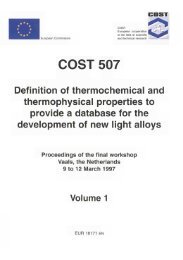Chef de projet : NOM Prnom - Repositório Aberto da Universidade ...
Chef de projet : NOM Prnom - Repositório Aberto da Universidade ...
Chef de projet : NOM Prnom - Repositório Aberto da Universidade ...
Create successful ePaper yourself
Turn your PDF publications into a flip-book with our unique Google optimized e-Paper software.
Premier Symposium Méditerranéen <strong>de</strong> Géoengineering «SMGE09» Alger 20 et 21 juin 2009<br />
Figure 2. Mesh used – structure 1 (A2).<br />
Calculation of the <strong>de</strong>formation modulus based on the numerical analysis<br />
First of all, it should be highlighted that a significant variability was obtained in the in situ<br />
displacements measured by geophones on the different test points. The calculation of the<br />
<strong>de</strong>formation modulus was done based on results obtained from the first height impact, i.e., for a<br />
peak load of approximately 20 kN.<br />
Initially, an attempt was ma<strong>de</strong> to find the <strong>de</strong>formation modulus of both the subgra<strong>de</strong> and the<br />
bottom capping layer, in or<strong>de</strong>r to <strong>de</strong>termine the outer part of the <strong>de</strong>flection basin (the most<br />
distant from the load application place). For this purpose, the <strong>de</strong>formation modulus of the<br />
treated soils was fixed on 200 MPa and the <strong>de</strong>formation modulus of the subgra<strong>de</strong> and of the<br />
untreated soil (indicated as “soil”) varied as showed in Table 2.<br />
Table 2. Hypotheses consi<strong>de</strong>red for the <strong>de</strong>formation modulus of the subgra<strong>de</strong> and untreated soil.<br />
E treated<br />
Deflections [μm]<br />
E soil E<br />
Hypothesis<br />
subgra<strong>de</strong><br />
soil<br />
Df1 Df2 Df3 Df4 Df5 Df6 Df7 Df8 Df9<br />
[MPa] 0 30 45 60 90 120 150 180 210<br />
1 50 80 434 218 144 99 55 35 25 19 16<br />
2 60 80 423 210 140 98 55 36 26 20 16<br />
3 80 100 372 170 111 77 44 29 21 16 13<br />
4 80 120 348 149 94 64 35 23 17 13 10<br />
200<br />
5 60 140 346 143 85 55 29 19 14 11 9<br />
6 80 160 317 122 72 47 26 17 13 10 8<br />
7 100 170 300 111 66 43 24 16 12 9 7<br />
8<br />
120 170 292 107 64 43 25 17 12 9 7<br />
The minimum and maximum <strong>de</strong>flection basins indicated in Figure 3, correspond to the minimum<br />
and maximum displacements measured by geophones. Hence, the minimum basin corresponds<br />
to the structure with the best mechanical characteristics and the maximum basin corresponds to<br />
the structure with the worst mechanical characteristics.
















